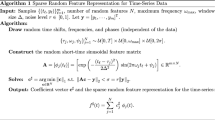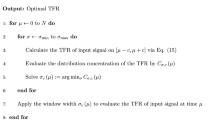Abstract
The generalized generating function (GGF), which can exploit the statistical information carried on complex-valued signals efficiently by treating its real and imaginary parts as a whole and offer an elegant algebraic structure, has been proposed by authors for blind identification of mixtures. In this paper, we extend the GGF-based method to be able to deal with the challenging underdetermined mixtures with complex-valued sources. A new algorithm named ALSGGF, in which the mixing matrix is estimated by decomposing the tensor constructed from the higher conjugate derivative of the second GGF of the observations with alternating least squares algorithm, is proposed. Furthermore, we show that the conjugate derivatives of different orders of the second GGF can be used jointly in a simple way to improve the performance. Simulation experiments validate the superiority of the proposed ALSGGF algorithms.




Similar content being viewed by others
References
A. Aissa-EI-Bey, N. Linh-Trung, K. Abed-Meraim, A. Belouchrani, Y. Grenier, Underdetermined blind separation of nondisjoint sources in the time–frequency domain. IEEE Trans. Signal Process. 55(3), 897–907 (2007)
Y. Chen, D. Han, L. Qi, New ALS methods with extrapolating search directions and optimal step size for complex-valued tensor decompositions. IEEE Trans. Signal Process. 59(12), 5888–5898 (2011)
P. Comon, M. Rajih, Blind identification of underdetermined mixtures based on the characteristic function. Signal Process. 86(9), 2271–2281 (2006)
P. Comon, X. Luciani, A.L.F. de Almeida, Tensor decompositions, alternating least squares and other tales. J. Chemom. 23, 393–405 (2009)
A.L.F. de Almeida, X. Luciani, A. Stegeman, P. Comon, CONDFAC decomposition approach to blind identification of underdetermined mixtures based on generating function derivatives. IEEE Trans. Signal Process. 60(11), 5698–5713 (2012)
F. Gu, H. Zhang, D. Zhu, Blind separation of complex sources using generalized generating function. IEEE Signal Process. Lett. 20(1), 71–74 (2013)
F. Gu, H. Zhang, W. Wang, D. Zhu, Generalized generating function with tucker decomposition and alternating least squares for underdetermined blind identification. EURASIP J. Adv. Signal Process. (2013). doi:10.1186/1687-6180-2013-124
A. Karfoul, L. Albera, G. Birot, Blind underdetermined mixture identification by joint canonical decomposition of HO cumulants. IEEE Trans. Signal Process. 58(2), 638–649 (2010)
J.B. Kruskal, Three-way arrays: rank and uniqueness of trilinear decompositions, with application to arithmetic complexity and statistics. Linear Algebra Appl. 18, 95–138 (1977)
L.D. Lathauwer, J. Castaing, Blind identification of underdetermined mixtures by simultaneous matrix diagonalization. IEEE Trans. Signal Process. 56(3), 1096–1105 (2008)
L.D. Lathauwer, B.D. Moor, J. Vandewalle, On the best rank-1 and rank-(\(R_{1}, R_{2}, \ldots, R_{N})\) approximation of higher-order tensors. SIAM J. Matrix Anal. Appl. 21, 1324–1342 (2000)
L.D. Lathauwer, J. Castaing, J.F. Cardoso, Fourth-order cumulant-based blind identification of underdetermined mixtures. IEEE Trans. Signal Process. 55(6), 2965–2973 (2007)
X. Luciani, A.L.F. de Almeida, P. Comon, Blind identification of underdetermined mixtures based on the characteristic function: the complex case. IEEE Trans. Signal Process. 59(2), 540–553 (2011)
D. Nion, L.D. Lathauwer, An enhanced line search scheme for complex-valued tensor decompositions: application in DS-CDMA. Signal Process. 88(3), 749–755 (2008)
M. Rajih, P. Comon, Alternating least squares identification of underdetermined mixtures based on the characteristic function, in Proceedings of ICASSP’06, Toulouse, France, 2006, pp. III-117/III-120
A. Slapak, A. Yeredor, Charrelation and charm: generic statistics incorporating higher-order information. IEEE Trans. Signal Process. 60(10), 5089–5106 (2012)
N.D. Sidiropoulos, R. Bro, On the uniqueness of multilinear decomposition of N-way arrays. J. Chemom. 14, 229–239 (2000)
L. Sorber, M.V. Barel, L.D. Lathauwer, Optimization-based algorithms for tensor decomposition: canonical polyadic decomposition, decomposition in rank-(\(L_{r}\), \(L_{r}\), 1) terms, and a new generalization. SIAM J. Optim. 23(2), 695–720 (2013)
S. Xie, L. Yang, J. Yang, G. Zhou, Y. Xiang, Time–frequency approach to underdetermined blind source separation. IEEE Trans. Neural Netw. Learn. Syst. 23(2), 306–316 (2012)
A. Yeredor, Blind source separation via the second characteristic function. Signal Process. 80(5), 897–902 (2000)
Acknowledgments
The authors would like to thank the anonymous reviewers for their careful reading and helpful remarks, who have contributed to improve the clarity of the paper. This work is supported in part by the Natural Science Foundation of China under Grant 61001106, the National Program on Key Basic Research Project of China under Grant 2009CB320400, and the Major Projects of the National Natural Science Foundation of China under Grant 91338105.
Author information
Authors and Affiliations
Corresponding author
Appendix
Appendix
In this Appendix, we show the computational details of core equation in (8).
First, the differentiation of (8) with respect to \(u_{q_1 }^*\) gives
Similarly, the differentiation of (8) with respect to (\(u_{q_1 }^*,u_{q_2 }^*,\ldots ,u_{q_K }^*)\) gives
Defining \( G_{p} = \partial ^{K} \left( {\varphi _{p} (\sum \nolimits _{q} {A_{{qp}}^{*} u_{q} } )} \right) /\partial \left( {\left( {\sum \nolimits _{q} {A_{{qp}}^{*} u_{q} } } \right) ^{*} } \right) ^{K} \), we can rewrite (20) in a more compact form as in (9).
Rights and permissions
About this article
Cite this article
Gu, F., Zhang, H., Wang, S. et al. Blind Identification of Underdetermined Mixtures with Complex Sources Using the Generalized Generating Function. Circuits Syst Signal Process 34, 681–693 (2015). https://doi.org/10.1007/s00034-014-9858-6
Received:
Revised:
Accepted:
Published:
Issue Date:
DOI: https://doi.org/10.1007/s00034-014-9858-6




